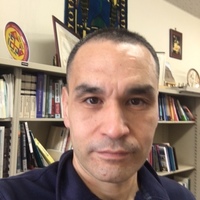
Timur Dadabaev
Professor of International Relations and the Director of the Special Program for Japanese and Eurasian Studies at the Graduate School of Social Sciences and Humanities, University of Tsukuba, Japan.
Address: 1-1-1, Tennodai,
Tsukuba-shi, Ibaraki-ken,
Japan, 305-8571
Address: 1-1-1, Tennodai,
Tsukuba-shi, Ibaraki-ken,
Japan, 305-8571
less
Related Authors
Rustamjon Urinboyev
Lund University
Marlene Laruelle
The George Washington University
Abel Polese
Tallinn University
Wolfgang Drechsler
Tallinn University of Technology
Abdillah Noh
The University of Nottingham Malaysia Campus
Eugenie Samier
University of Strathclyde, Glasgow
Yunus Emre Gürbüz
Kyrgyz-Turkish Manas University
Birgit Schlyter
Stockholm University
Eric Schluessel
The George Washington University
InterestsView All (21)










Uploads
Papers by Timur Dadabaev
https://link.springer.com/epdf/10.1007/s10308-020-00589-w?sharing_token=oGdy4DFajFdfQcZLydPoXfe4RwlQNchNByi7wbcMAY4ShBgJLamJ_oFWPQUIP9OwYnQDBRr7kC_EBwWWJ50pb8G3Au3MnMzD2I8UGGFkhk2G-ugphGuZgM3o18mhr92CRJlsXxBbNuvDLjd2n94Z3VwbXfqT4thQjbHT5H9acjo%3D
and unskilled labor migration from Uzbekistan to Japan and South
Korea. Labor migration and educational mobility are becoming the
next “horizon” in the expanded relationship between East and Central
Asia, powered by several factors, including the efforts by Japan and
South Korea to build “original” people-oriented policy engagements
with the region and the demand from Central Asian states, such as
Uzbekistan, to provide more labor opportunities to their young and
growing populations. This paper presents the initial findings of a pilot
survey that explores and occasionally compares the experiences of
Uzbek migrants to Japan and South Korea, using datasets of faceto-face interviews related to various aspects of life in Japan and
South Korea. The interviews were conducted face to face and online
(Telegram, Skype, etc.) with 66 migrants and Japanese language school
students (whom this paper treats as labor migrants masquerading as
students) in Japan from November 2019 to January 2020 as well as
online with 30 laborers and students in South Korea from August to
September 2020
In terms of the narrative of this article, this paper will first explore the problem of the securitization of the CA region and the cooperation agenda. The paper then discusses the motivations of Uzbekistan and its cooperation counterparts in pursuing closer ties. This discussion will then be followed by an analysis of how the new leadership in Uzbekistan re-evaluated its past behavior to address its post and neocolonial challenges and the cooperation agendas with Russia, China, South Korea and Japan.
(This paper has also been translated into Chinese language and annotated by Shao Liang, Renmin, https://zhuanlan.zhihu.com/p/129026367)
https://link.springer.com/epdf/10.1007/s10308-020-00589-w?sharing_token=oGdy4DFajFdfQcZLydPoXfe4RwlQNchNByi7wbcMAY4ShBgJLamJ_oFWPQUIP9OwYnQDBRr7kC_EBwWWJ50pb8G3Au3MnMzD2I8UGGFkhk2G-ugphGuZgM3o18mhr92CRJlsXxBbNuvDLjd2n94Z3VwbXfqT4thQjbHT5H9acjo%3D
and unskilled labor migration from Uzbekistan to Japan and South
Korea. Labor migration and educational mobility are becoming the
next “horizon” in the expanded relationship between East and Central
Asia, powered by several factors, including the efforts by Japan and
South Korea to build “original” people-oriented policy engagements
with the region and the demand from Central Asian states, such as
Uzbekistan, to provide more labor opportunities to their young and
growing populations. This paper presents the initial findings of a pilot
survey that explores and occasionally compares the experiences of
Uzbek migrants to Japan and South Korea, using datasets of faceto-face interviews related to various aspects of life in Japan and
South Korea. The interviews were conducted face to face and online
(Telegram, Skype, etc.) with 66 migrants and Japanese language school
students (whom this paper treats as labor migrants masquerading as
students) in Japan from November 2019 to January 2020 as well as
online with 30 laborers and students in South Korea from August to
September 2020
In terms of the narrative of this article, this paper will first explore the problem of the securitization of the CA region and the cooperation agenda. The paper then discusses the motivations of Uzbekistan and its cooperation counterparts in pursuing closer ties. This discussion will then be followed by an analysis of how the new leadership in Uzbekistan re-evaluated its past behavior to address its post and neocolonial challenges and the cooperation agendas with Russia, China, South Korea and Japan.
(This paper has also been translated into Chinese language and annotated by Shao Liang, Renmin, https://zhuanlan.zhihu.com/p/129026367)
Also available at: available at https://japan.ahk.de/jp/infothek/aktuelles/aktuelles-details/eu-japan-joint-study-on-connectivity-cooperation, 2021-12
https://doi.org/10.1177/18793665211050645
Timur Dadabaev
https://www.eastwestcenter.org/system/tdf/private/ewc_policy_studies_78_web.pdf?file=1&type=node&id=37122
China, Japan, and South Korea have regarded Central Asia as a new Asian frontier in their foreign policies since the collapse of the Soviet Union. With time, their policies evolved into regionbuilding initiatives exemplified by the Shanghai Cooperation Organization, Belt and Road Initiative, Central Asia plus Japan Dialogue Forum, and Korea-Central Asia Cooperation Forum. This paper raises the following research questions: What are the areas of interest for China, Japan, and Korea in their relations with Central Asian states and Uzbekistan in particular? What are the patterns of agenda setting in establishing intergovernmental cooperation? What are the particular projects that these states initiate? What are the objectives of projects initiated within these areas of interest? How competitive or complementary are these projects of China, Japan, and Korea? Throughout, Chinese, Japanese, and Korean “Silk Road” roadmaps with Uzbekistan are discussed to highlight their similarities and differences.
Reviewed by Kuniko Ashizawa, in International Relations of Asia Pacific (2016)
doi: 10.1093/irap/lcw019
http://irap.oxfordjournals.org/content/early/2016/11/28/irap.lcw019.full
contribute to academic knowledge with regards to how people remember their Soviet past. In addition, this study may also shed new light on the transformations of present-day Central Asia, from the perspective of personal memories. The way in which people in Central Asia reconcile with their Soviet past is to a great extent
through a three-fold process of recollecting their everyday experiences, reflecting on their past from the perspective of their post-Soviet present, and re-imagining their own history.
• Guest Editor’'s Introduction to the Special Issue | Alexander Bukh
| ARTICLES
• “"We Want a State of Our Own!”"
Reconstructing Community Space in Bordering Areas of Central Asia | Timur Dadabaev
• Uneasy Pairs :
Revitalizations of Karen Ethno-Nationalism
and Civil Society across the Thai-Burmese Border | Alexander Horstmann
• Illegality & Alterity :
Preliminary Notes on SEZ, Civil Society,
and the Thai-Burmese Borderland | Decha Tangseefa
• Intersections between Civil Society, Insurgency, and Development:
Case of the Subnational Confl ict in the South of Thailand | Ora-orn Poocharoen
• Assessing Local Responses to Chinese-Backed Resource Development
Projects in Myanmar and Cambodia: A Critical Survey | Pichamon Yeophantong
• Japanese Activists, the Environment,
and Border-Crossing Movements in Asia | Simon Avenell
| BOOK REVIEWS
• Translating Critical Border Studies in East Asia | Jason Young
• A Critical Development of Border Studies | Fuminori Kawakubo
Not long ago, we entered a new millennium. Among Inner Asian Turkic populations, where societies are developing and growing with this new millennium, there is a search for cultural historical legacies with the aim of identifying features of nationhood or arriving at some related comprehension of belonging to a specific societal community.
History means “past” – near past or remote past. Does this search for a cultural historical identity entail efforts to resuscitate, or revitalize, cultural features or patterns from the past? Is it possible to revive cultural patterns belonging to another era? The territory – the geographical area – is the same as it was in the past. Its inhabitants are people with memories and narrations of traditions and life among ancestors living on the same territory during long stretches of time. How is this past to be accessed and how is it to be interpreted by present-day man, in another era and in a world where people’s lives are lived in quite another fashion and under quite different conditions from those of bygone days?
In a more general perspective, it is often stated by those who are cautious about traditions andlegacies that societies need to rest on history. If this is true and if societies do in fact need their history, why is this so and, furthermore, what is it that constitutes our knowledge of past times, our knowledge of our own past? How is historical knowledge created and how is it to be narrated in order to become historical knowledge for future generations? What is envisioned in historical narration and where do we look in order to find that which can be turned into historical knowledge? Finally, what may trigger revisions of such narration? These are questions central to the accounts offered in the following chapters of the present book.
The need and search for cultural and historical images may seem to be determined and influenced to a considerable degree by current political circumstances at different levels – not least regional and other levels beyond the individual state. Some of the chapters focus on such synchronic circumstances rather than long-term historiographies. Nevertheless, whatever temporal settings and geographical extensions are chosen, all presentations are contributions to the study of nation building or – with the term used in one of the ensuing chapters – “nation branding”.
The first two contributions to the present volume are accounts from broad regional and interregional perspectives drawing attention to current post-Soviet changes in terms of both political conditions and identity formation. The chapter On Oral History of the Soviet Past in Central Asia by Timur Dadabaev, Tsukuba University, addresses methodological issues relating to the question as to how new historiographies could also be shaped by common-man “lived” experiences elicited from personal memories of the Soviet past by elderly people who were once Soviet citizens living in Uzbekistan, Kazakhstan or Kyrgyzstan.
In her chapter, The Coverage of Central Asia in Turkey, the Turkish scholar Büşra Ersanlı from Marmara University, Istanbul, comments on the development and modifications of Turkey’s foreign policy towards the young ex-Soviet Central Asian states and the endeavors of this country to determine its role as one – and in many respects the leading – member of a large Turkic world where coordination and cooperation have gained greater potentials than ever before.
Emre Gürbüz, Kyrgyzstan-Turkey Manas University, Bishkek, with his chapter titled In Search of New Historiographies for Ex-Soviet Turkic States, likewise includes Turkey in his survey of works on new history writing in Azerbaijan, Uzbekistan, and Kazakhstan. This time the former country is contrasted to the latter three republics from the point of view of territoriality, which the author identifies as “one of the main characteristics of post-Soviet historiographies”. The three ex-Soviet republics under investigation are shown to base their claims on legitimacy as sovereign states on “conventional territorial understanding”, albeit under partly different socio-political legacies and, furthermore, with differing visions as to future objectives for their respective nation-states.
The account of History-Writing and History-Making in Azerbaijan by Zaur Gasimov at the German Orient-Institut Istanbul could be read as a comment on such future objectives as regards one of these three states – Azerbaijan. The author offers a thorough survey of new trends in post-Soviet Azerbaijani history-writing with regard to both the choice of topics and interpretation as well as language (Azerbaijani rather than Russian) and style, although there amy be new obstacles and taboos due to present-day policies.
From the perspective of “a post-modern world of images and influence”, Anita Sengupta, fellow of the Maulana Abul Kalam Azad Institute of Asian Studies, Kolkata, takes the Republic of Uzbekistan under scrutiny in a chapter subtitled The Politics of Nation Branding in Uzbekistan. There she writes that “modern nations are in actuality based on invented traditions and the continuous mobilization and adaptation of history” in order to “reposition themselves in a fluid globalizing world” and that “nation-state building is no longer an activity confined to the domestic arena”.
The significance of language in sociopolitical development and nation building is highlighted in the remaining three chapters of this volume. Two of them focus on the language situation in Uzbekistan and the interdependence of language and identity formation, whereas the third chapter deals with language development in the late 19th-century Xinjiang. Rano Turaeva-Hoehne, Max Planck Institute for Social Anthropology, Halle, refers to ethnographic fieldwork among Khorezmian migrants in Tashkent when commenting on the use of different linguistic codes “for communicating collective and social identities in a multiethnic context”, in her paper concerning Linguistic and Social Contradictions within Uzbek National Identity.
In her chapter titled The Status of Uzbek as “National Language” the SRII Director Birgit N. Schlyter, Istanbul, examines the post-Soviet Uzbek state language from the point of view of three parameters – “distribution”, “corpus”, and “manifestation” – for an evaluation of the chances for this language to become a symbol of Uzbekistani national identity. In particular the third parameter is crucial relating to the “narrative capacity” of language and the loyalty towards a state or community through language.
The author of Language and State in Late Qing Xinjiang, Eric T. Schluessel from Harvard University, wants to show how the very concept of language changed in the final years of Qing rule and writes that language “was conceived of not just as a system of varieties marking kinds of people, but as an instrument of reform and an institution of power”. He describes a rather complex language situation that could not be characterized merely in terms of one language community (Chinese) dominating another (Turki). For a general comment on the relationship between language and society, he finds it “useful to examine national identity and language attitudes as part of an ongoing process of negotiation between state and other actors promoting competing language regimes and linguistic institutions”.
The authors of these chapters have all been participating in research work conducted within the framework of the Stockholm International Program for Central Asian Studies (SIPCAS). Their contributions originate from papers presented at conferences and workshops arranged or co-organized by SIPCAS for discussions of societal change and transformation in the wake of the Soviet demise. Issues of cultural historical legacies and nation-state legitimacy have been at the top of the agenda.
As usual, the spelling of names and titles has been an intricate issue, the more so as variations are due to not only personal preferences but also the fact that different alphabets (e.g. Cyrillic or Latin for Azerbaijani names) may have been used for one and the same reference. There has been homogenization to a certain degree, especially in the spelling of scientific terms, linguistic and others (e.g. Kipchak, not Kypchak or Qipchaq). Moreover, American spelling has been chosen whenever there has been an option contrasting with a British alternative. In certain cases, on the other hand, the authors have been free to use a spelling of their own choice, independent of the spelling of the same word or name in another chapter (e.g. Uyghur in one chapter versus Uighur in another).
The abovementioned SIPCAS program encourages and welcomes the participation of young researchers and students. During work on the manuscript of this volume much help was offered by Nina Lind while on a one-month internship at the Swedish Research Institute in Istanbul and by Azize Güneş, who was my assistant throughout the whole editing process and shared the proofreading of all chapters with me. It was a great pleasure to work with them, and I’m much obliged to their cautious efforts.
Istanbul, May 2014
The Editor